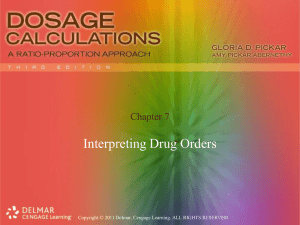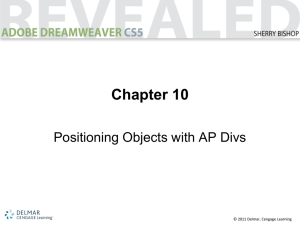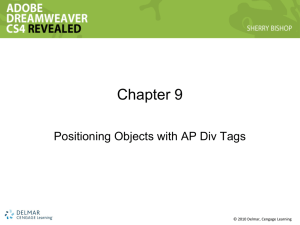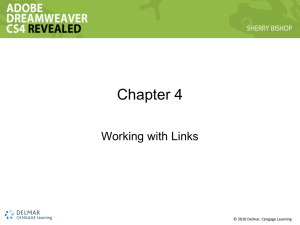Chapter 16
advertisement
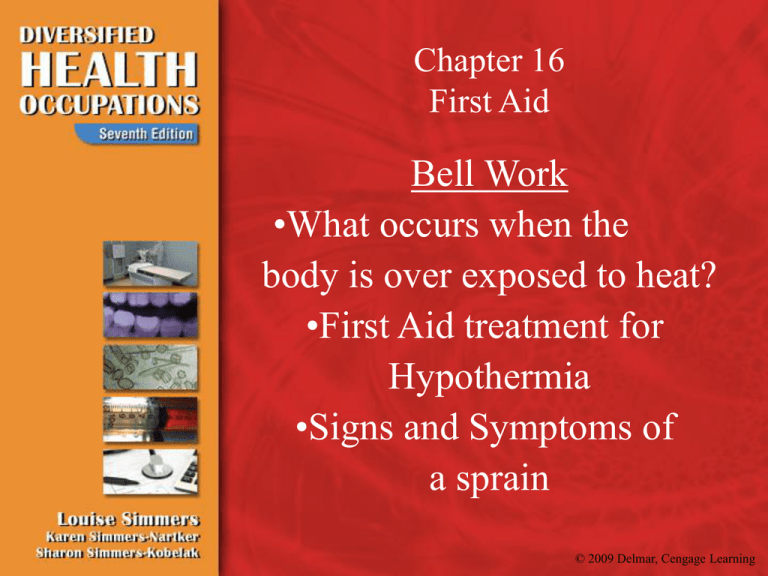
Chapter 16 First Aid Bell Work •What occurs when the body is over exposed to heat? •First Aid treatment for Hypothermia •Signs and Symptoms of a sprain © 2009 Delmar, Cengage Learning 16:7 Providing First Aid for Heat Exposure • Overexposure to heat may cause a chemical imbalance in the body • Occurs when water and salt are lost through perspiration • Also occurs when body cannot eliminate excess heat © 2009 Delmar, Cengage Learning Heat Cramps • • • • Muscle pains and spasms Caused by exposure to heat Loss of water and salt Apply firm pressure on cramped muscle to provide relief • Provide rest and move to cooler area • Small sips of water or electrolyte solution (e.g., sports drink) © 2009 Delmar, Cengage Learning Heat Exhaustion • Occurs when exposed to heat with loss of fluids through sweating • Signs and symptoms – – – – – Pale clammy skin Diaphoresis Fatigue Dilated pupils and HA Muscle Cramps • First aid care © 2009 Delmar, Cengage Learning Heat Exhaustion First Aid • • • • • Move to cooler area Apply cool wet clothes Lie victim down with feet elevated Give small sips of water Get help and watch for shock © 2009 Delmar, Cengage Learning Heat Stroke • Prolonged exposure to higher than normal temperatures • Medical emergency—needs immediate care and attention • Body unable to eliminate excess heat • Signs and symptoms – – – – ↑ Body Temp Red, hot and dry skin Rapid pulse Pupils constricted © 2009 Delmar, Cengage Learning Heat Stroke First Aid • Cool victim quickly • Sponge or place in tub of cool water or alcohol • Watch for shock • Give nothing by mouth • Get help © 2009 Delmar, Cengage Learning In Conclusion… • Warn victim to avoid warm or hot temperatures for several days after recovering from heat exposure condition • Encourage recovered victim to drink sufficient amounts of water and to have an adequate intake of salt © 2009 Delmar, Cengage Learning © 2009 Delmar, Cengage Learning 16:8 Providing First Aid for Cold Exposure • Exposure to cold temperatures can cause body tissues to freeze and body processes to slow down • Needs immediate attention • Degree of injury affected by wind velocity, amount of humidity, and length of exposure to cold © 2009 Delmar, Cengage Learning Hypothermia • When body temperature is less than 95ºF (35ºC) • Caused by prolonged exposure to cold • Signs and symptoms – Shivering, numbness, weakness or drowsiness • Death can occur if body processes become too slowed down © 2009 Delmar, Cengage Learning Hypothermia First Aid • • • • Move to warm area Remove wet clothes Warm victim slowly by blanket or bath Give warming liquids by mouth (no caffeine) © 2009 Delmar, Cengage Learning What is the condition? © 2009 Delmar, Cengage Learning Frostbite • Freezing of tissue fluids with damage to the skin and underlying tissues • Caused by exposure to freezing or below-freezing temperatures • Early signs and symptoms – Redness and tingling • Other signs and symptoms as frostbite progresses – Pale, glossy skin, Blisters possible, numbness and pain, lethargic (continues) © 2009 Delmar, Cengage Learning © 2009 Delmar, Cengage Learning Frostbite • Objectives of first aid – Maintain respirations – Treat for shock – Warm affected parts • Common sites: fingers, toes, ears, nose, cheeks • First aid care • Assess for signs and symptoms of shock and treat as needed © 2009 Delmar, Cengage Learning Frostbite First Aid Care • Warm affected parts • Never rub or massage area because this may cause gangrene or death of the tissue • Avoid opening or breaking any blisters • Place dry sterile dressing between affected toes or fingers to prevent them from rubbing and causing further injury. © 2009 Delmar, Cengage Learning © 2009 Delmar, Cengage Learning 16:9 Providing First Aid for Bone and Joint Injuries • Frequently occur during accidents or falls with variety of injuries • Examples: fractures, dislocations, sprains, and strains • May have more than one type of injury to bones and joints at the same time © 2009 Delmar, Cengage Learning Fracture • Break in the bone • Closed or simple fracture – No open wound on the skin • Compound or open fracture – Open wound on the skin • Objectives of first aid © 2009 Delmar, Cengage Learning © 2009 Delmar, Cengage Learning Fracture Signs and symptoms • • • • • • • Deformities Limited motion Pain and tenderness Swelling and discoloration Protrusion Hearing the break or snap Victim feels a grating sensation of abnormal movement © 2009 Delmar, Cengage Learning Fracture Objectives of first aid • • • • Maintain respirations Treat for shock Keep the broken bone from moving Get Help © 2009 Delmar, Cengage Learning Dislocation • When the end of the bone is displaced from a joint or moved out of its normal position within a joint • Tearing or stretching of ligaments, muscles, and other soft tissues also frequently occurs • First aid care © 2009 Delmar, Cengage Learning Dislocation • Signs and symptoms – – – – – Deformities Limited motion Pain and tenderness Swelling and discoloration Shortening or lengthening of affected arm or leg • First aid care -Same as a fracture © 2009 Delmar, Cengage Learning Sprain-Ligaments • • • • Injury to tissues surrounding a joint Common sites: ankles and wrists Signs and symptoms Sprains frequently resemble fractures or dislocations—treat as fracture if any doubt • First aid care – PRICE © 2009 Delmar, Cengage Learning Strain-Tendons • • • • • Overstretching of a muscle Caused by overexertion or by lifting Frequent site: back Signs and symptoms First aid treatment – PRICE © 2009 Delmar, Cengage Learning Splints • Devices to immobilize injured parts • Types of splints – Pneumatic or air splints – Padded boards – Traction splints • Splints can also be made from cardboard, newspapers, pillows, boards, etc. (continues) © 2009 Delmar, Cengage Learning © 2009 Delmar, Cengage Learning Splints • Need to be long enough to immobilize the joint above and below the injured area to prevent movement • Should be padded • Tied in place • Apply as not to create pressure on affected area • If open wound, control bleeding before applying splint (continues) © 2009 Delmar, Cengage Learning Splints • Never attempt to reposition bone • Splint before moving victim • Observe precautions when using pneumatic splints • Traction splints – Use only if have been trained © 2009 Delmar, Cengage Learning Circulation Check After Splint • • • • • • • Verify that the splints are not too tight Check skin temperature Check color Note swelling or edema Numbness or tingling Check pulse If circulation impaired, immediately loosen the ties © 2009 Delmar, Cengage Learning Slings • Commercial slings • Triangular bandages • Use: support arm, hand, forearm, and shoulder • Positioning of sling – Elevate if possible to reduce swelling and decrease pain • Check circulation • Limit movement of limb (continues) © 2009 Delmar, Cengage Learning Slings (continued) • If using knots – Placement – Padding • Considerations for shoulder injury © 2009 Delmar, Cengage Learning © 2009 Delmar, Cengage Learning

